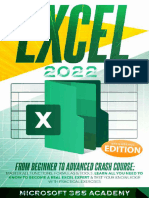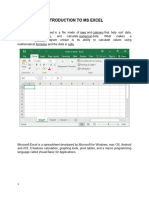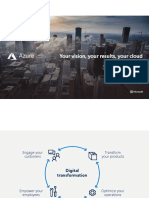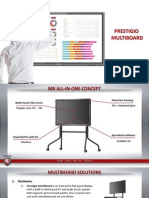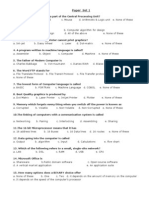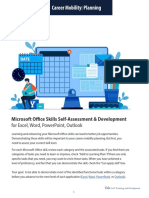Microsoft Excel: Step-by-Step Guide
Microsoft Excel: Step-by-Step Guide with Examples
Introduction
Microsoft Excel is a powerful spreadsheet tool used for data analysis, calculations, visualization, and
more. This guide covers Excel from the basics to advanced features, focusing on practical examples
and case studies.
Chapter 1: Understanding the Excel Interface
- Workbook and Worksheet: A workbook contains multiple worksheets (tabs).
- Ribbon and Tabs: The Ribbon is divided into tabs like Home, Insert, Page Layout, Formulas, Data,
Review, and View.
- Cells, Rows, and Columns: The basic structure where data is entered.
- Quick Access Toolbar: For commonly used commands like Save, Undo, and Redo.
Chapter 2: Home Tab Features
Clipboard
- Cut, Copy, Paste: Moving and copying data.
- Paste Special: Paste specific attributes like values, formulas, formats.
Font
- Changing font type, size, color.
- Applying bold, italic, underline.
- Using borders and fill colors for cell emphasis.
Alignment
- Align text (left, center, right).
- Merge & Center.
Page 1
� Microsoft Excel: Step-by-Step Guide
- Wrap Text to fit content inside a cell.
Number
- Formatting numbers as currency, percentage, date, etc.
- Custom formatting for specific needs.
Styles
- Apply conditional formatting based on rules.
- Use cell styles for quick formatting.
Editing
- Find & Replace.
- Sort & Filter data.
- Clear contents or formats.
Example: Create a simple expense tracker and use formatting to highlight overspending.
Chapter 3: Insert Tab Features
- Tables: Convert data into an Excel table for easier manipulation.
- Charts: Create visualizations like bar, line, and pie charts.
- Sparklines: Tiny charts within a cell.
- Illustrations: Insert images, shapes, and icons.
- Text Boxes: Add explanations to charts or data.
Case Study: Visualize sales data with charts to identify trends.
Chapter 4: Formulas Tab Features
- Function Library: SUM, AVERAGE, IF, VLOOKUP, HLOOKUP, INDEX, MATCH.
- Named Ranges: Assign names to cell ranges for easier formula writing.
- Formula Auditing: Trace precedents and dependents to debug formulas.
Example: Use VLOOKUP to pull employee details from a database.
Page 2
� Microsoft Excel: Step-by-Step Guide
Chapter 5: Data Tab Features
- Sort & Filter: Organize and view data based on conditions.
- Data Tools: Remove duplicates, data validation, and text-to-columns.
- What-If Analysis: Use Goal Seek and Scenario Manager for forecasting.
Case Study: Forecast product demand using historical data.
Chapter 6: Review Tab Features
- Spell Check: Correct spelling errors.
- Comments: Add notes for clarity.
- Protect Sheet/Workbook: Restrict editing permissions.
Example: Add comments and protect a financial report shared with a team.
Chapter 7: View Tab Features
- Freeze Panes: Keep headers visible when scrolling.
- Zoom and Page Layout: Adjust for better viewing and printing.
- Gridlines and Headings: Show or hide for a cleaner view.
Example: Freeze column headers for easier data navigation.
Chapter 8: Advanced Features
- Pivot Tables: Summarize large datasets dynamically.
- Macros: Automate repetitive tasks.
- Power Query: Import and transform data from external sources.
Case Study: Create a pivot table to analyze annual sales and automate it using macros.
Chapter 9: Tips and Tricks
Page 3
� Microsoft Excel: Step-by-Step Guide
- Use shortcuts for efficiency.
- Best practices for data entry and formula writing.
- Data validation for reducing errors.
Conclusion
By mastering these Excel features, you'll be equipped to handle data efficiently, create impactful
reports, and automate repetitive tasks. Practice with the examples and case studies for deeper
understanding.
Appendix
- Common keyboard shortcuts.
- Troubleshooting common issues.
- Additional resources for advanced learning.
Page 4













